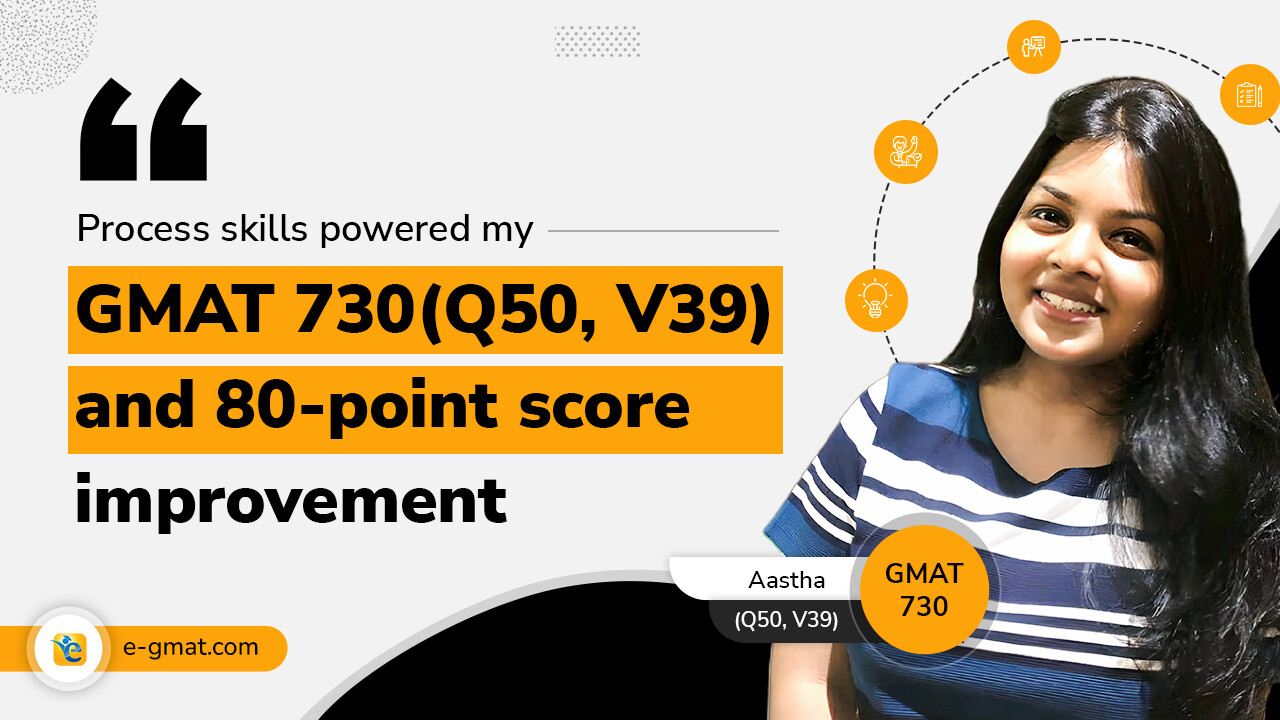GMAT 730(Q50, V39) scorer Aastha, a Chartered Accountant, believes the most challenging part of her GMAT journey was to unlearn the skills she had learned by studying free resources. Those skills helped her score only a 650 on her previous attempt at the GMAT. But, for a higher target, she required a structured program and strategies that deliver exceptional results.
Academically strong, Aastha was confident in her quant and enrolled in the e-GMAT course to build her verbal ability. But while navigating the e-GMAT course, she discovered various new and time-efficient methods tailored to solve even the hardest GMAT questions. She realized that she needed to unlearn a lot of what she knew and focus on learning the right skills, not just for verbal but also for quant.
She diligently practiced mastering the methodologies the e-GMAT course offers for each sub-section. She also formulated many of her own strategies and was able to use them beyond their apparent purviews, such as using the meaning-based approach and pre-thinking for DS questions in quant.
Watch Aastha talk about her apprehensions about adopting the new methods, methods which eventually led her to an 80-point score improvement and an incredible 95th percentile on the GMAT test.
Rida: Congratulations Aastha on your GMAT 730(Q50, V39). I know you’ve put in a lot of time, energy, and effort to get that score. How does it feel?
Aastha: I am pretty elated to have this score, and I worked really hard. I couldn’t believe that I was able to achieve this score. I am super happy.
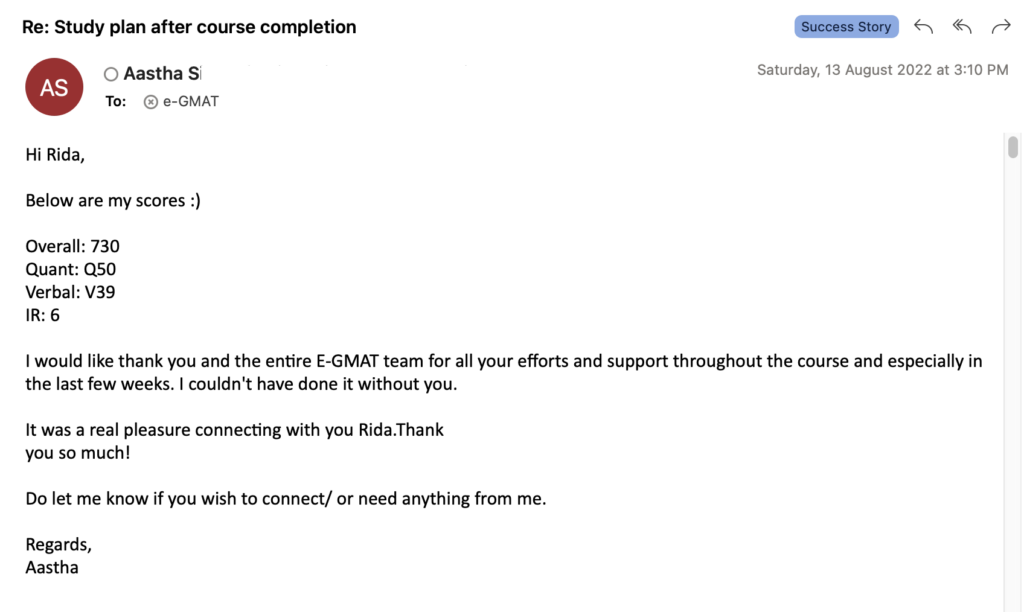
Rida: The proof is in the pudding now, and we have the result finally. Let’s give our audience some background and tell them about you.
Aastha: Hello, everyone! My name is Aastha S. I am a 25-year-old Chartered Accountant working as a Tax Professional in a Big Four company.
Journey from GMAT 650 to e-GMAT
Rida: This was your second attempt at the GMAT. Could you tell us about your first experience with preparations and the exam?
Aastha: I gave my first GMAT a year back and scored 650. I spent very little time on preparation compared to the time I put in this time. While working full time, I prepared for about a month, and that too with breaks.
Rida: What changed this time when you decided to retake the test?
Aastha: This time, I took a break from my work as I would need targeted practice and consistency in my preparation if I had to attempt the exam again.
Rida: It makes sense, as the GMAT demands a lot of effort and consistency, as you mentioned. How long did you plan on preparing for the GMAT?
Aastha: This time, I spent two and a half to three months on GMAT preparation.
Rida: Did you spend time preparing on your own or started directly with the e-GMAT course?
Aastha: First, I started on my own, but I felt a bit lost as I was going back to it after a gap of almost seven-eight months. GMAT prep can be overwhelming, especially with the old notes I had prepared; I did not know where to start. With so much to cover, I was clueless about how much time I needed to spend on sections or about how to plan my preparation in areas I was already good at. Also, I needed to change my approach because self-study had not worked the first time. And that is how I came to e-GMAT.
Rida: You also took e-GMAT’s free trial. What convinced you to go for the course subscription?
Aastha: e-GMAT was referred to me by a friend. Before I enrolled, I went through the free lectures and realized that the entire course was so structured in its approach. It had process skills, application, and practice files for even the smallest topics. I really liked that and thought that having that entire course would definitely help me prepare for my GMAT. That’s when I decided to go for the complete course.
Benefits of learning basics in GMAT verbal
Rida: You first encountered the Master Comprehension course at the start of the verbal section. What role did it play in your verbal improvement?
Aastha: The Master Comprehension course made critical value additions such as understanding pause points, reading very complex or long sentences, or how to have a strategic reading approach. It really changed my verbal game.
The Master Comprehension course made critical value additions such as understanding pause points, reading very complex or long sentences, or how to have a strategic reading approach. It really changed my verbal game.
Rida: Was reading now different from how you used to read before you went through the course?
Aastha: Yes, definitely. Verbal was my weak area; I did not know how to approach long, language-heavy RC passages. New learnings from Master Comprehension, such as reading strategies, pause points, and the meaning-based approach, helped me throughout the entire e-GMAT course.
Rida: After Master Comprehension, you moved to SC. How was your experience with the SC course?
Aastha: I was reasonably comfortable with SC even before I took the course. But one crucial value addition with e-GMAT was the meaning-based approach for SC. I struggled with those questions where answer choices were grammatically correct but would have changed meaning from the original sentence. The Meaning-Based Approach helped me faster eliminate those deceiving answer choices.
Pre-thinking: the game changer
Rida: After SC, you moved to Critical Reasoning. How did your CR journey go?
Aastha: Critical Reasoning was my weak point throughout the verbal course; I used to get stuck with the answer choices. But e-GMAT’s pre-thinking approach was a game changer for me. It took me a lot of practice; I had to go through the application files multiple times before I could efficiently apply pre-thinking. But it definitely changed the way I approached CR questions. Before analyzing the answer choices, it takes about 15-20 seconds to pre-think. As you practice the method, you also learn to identify patterns in all the CR questions.
Critical Reasoning was my weak point throughout the verbal course; I used to get stuck with the answer choices. e-GMAT’s pre-thinking approach was a game changer for me. It took me a lot of practice before I could efficiently apply pre-thinking. But it definitely changed the way I approached CR questions. Before analyzing the answer choices, it takes about 15-20 seconds to pre-think.
Rida: I am glad that pre-thinking helped you convert your weakness into a strength. You also understood that it’s necessary to spend a little time on the question stem itself before you start analyzing answer choices. That was a common trend for you in quant as well as verbal. Could you elaborate on that?
Aastha: Data Sufficiency questions from quant require a lot of analysis of the question statement. Like pre-thinking in CR questions, if you spend those extra 15 seconds understanding Data Sufficiency questions, you’ll save a lot of time while approaching the answer choices.
Earlier I used to jump to answer choices directly. This process significantly reduced my time for both types of questions in the GMAT exam
Data Sufficiency questions from quant require a lot of analysis of the question statement. Like pre-thinking in CR questions, if you spend those extra 15 seconds understanding Data Sufficiency questions, you’ll save a lot of time while approaching the answer choices.
Rida: So, spending a little extra time thinking saved you a lot of solving time overall?
Aastha: Initially, I was very apprehensive about this method. I think most of the people would resonate with me on this as how could spending more time on a question help in saving time eventually.
I’d take about a minute at the initial stage of practicing pre-thinking. But later, while solving medium and hard-level problems, I realized that it did not even take a minute or even 40 seconds each time. As you practice consistently, you eventually cut that time down as well. That process becomes second nature to you.
Rida: Now that you were done with SC and CR, how was it coming to RC?
Aastha: I was pretty comfortable by then. Having gone through the master comprehension, Sentence Correction, and Critical reasoning gave me a lot of insights on how one should approach long, complex sentences or passages. Identifying pause points at contextual words and other reading strategies helped me approach RC questions well.
I was much more comfortable now; even long RC passages didn’t scare me anymore. Also, I realized that shorter passages often have tougher inference or assumption questions. In contrast, longer passages would have detail questions, which are relatively more straightforward. It’s a myth that long passages are difficult; instead, I found shorter passages trickier.
Strategies to excel in GMAT quant
Rida: After RC, you jumped into quant. How helpful did you find the quant course with its PACE engine?
Aastha: PACE helped me shorten my preparation time significantly. The diagnostic quiz at the start of every sub-section determines which topics you need to study in detail. Although I was comfortable with quant even before e-GMAT, I needed targeted practice to reduce the time I took to solve questions. PACE optimized my prep time.
Rida: And this is where those process skills you learned during the course came in handy. Could you elaborate on how those process skills helped reduce your timing during the GMAT test?
Aastha: e-GMAT emphasizes 6 process skills such as simplifying, inference, applying constraints, etc., which greatly help the way you approach quant questions. Even for the trickier questions, when you analyze and use those skills, you realize the question was not really that tough. The pause points I learned during the verbal course influenced how I approached quant questions.
e-GMAT emphasizes 6 process skills such as simplifying, inference, applying constraints, etc., which greatly help the way you approach quant questions. Even for the trickier questions, when you analyze and use those skills, you realize the question was not really that tough. The pause points I learned during the verbal course influenced how I approached quant questions.
Rida: You also used pre-thinking or the ‘spend more time on the question to save time’ approach while solving questions in quant. Could you elaborate more on that?
Aastha: Yes, analyzing the question by spending 15 seconds before jumping to the answer choices is crucial. As you reach the answer choices, you often realize no further analysis is required.
Also, we Indians have this typical temptation to solve the question till the end; it’s essential to curb that temptation. If you already have your answer after analyzing the question, do not waste your time solving the question.
Rida: While going through e-GMAT, many find unlearning incorrect past rules and habits tricky. How did that process go for you?
Aastha: I realized there are not many concepts; it’s about how they test one concept in 50 different ways. It’s more important to apply the process and application skills correctly to save time than how you’d have done it otherwise.
I had to unlearn how I used to approach quant and learn new process skills that e-GMAT teaches. That was a massive value addition for me in the entire quant course. Applying those translation and simplification skills and considering relevant constraints as practice improved my approach to the questions. I’d not fall for the trap answer choices anymore.
Unlearning wasn’t easy as we all love maths and want to solve it in our own way, but there are better ways. You need to learn and apply those methods for necessary score improvements.
Unlearning wasn’t easy as we all love maths and want to solve it in our own way, but there are better ways. You need to learn and apply those methods for necessary score improvements.
Rida: However, going through the uncomfortable unlearning experience and stepping into something you’re unfamiliar with paid off for you with your Q50 score.
Aside from your Q50, I’d like to show your scholaranium stats to show everyone how effective your learning journey has been. Your performance here indicates the 85th percentile you eventually displayed in your GMAT test.
It’s very similar in both quants as well as verbal. It clearly indicates the hard work and consistent, methodical process you put into your preparation journey.
Even though it was all hard, I’m glad it paid off.
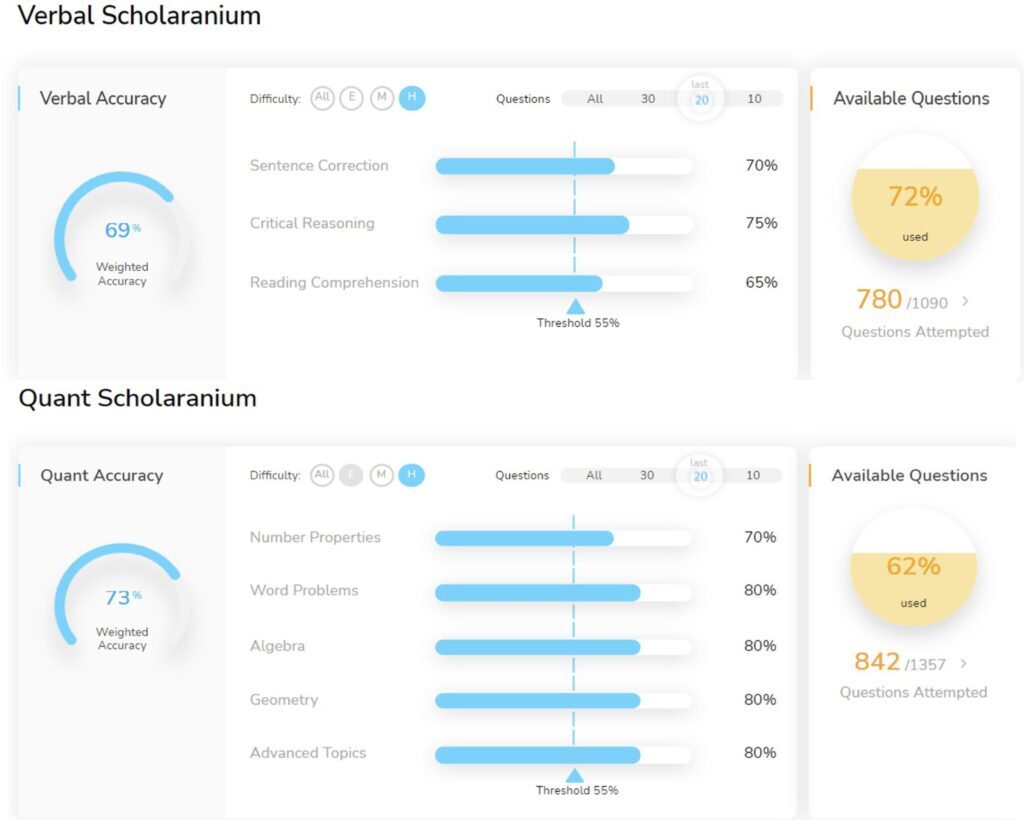
Last Mile Push for Aastha
Rida: We started working together around the time you were cementing quant. Tell us, what was your last leg of preparation like?
Aastha: I reached out to you, Rida, when I was in the last stage of course completion, asking about how to approach my first mock. Little did I know I still had a lot of gaps even after my course completion. You started by giving me improvement plans for every day and topics I needed to focus on more.
Today, I cannot stress enough how much it helped me in my entire GMAT mock journey. If I’d jumped to mocks right after the course completion, I don’t think I’d have performed that well.
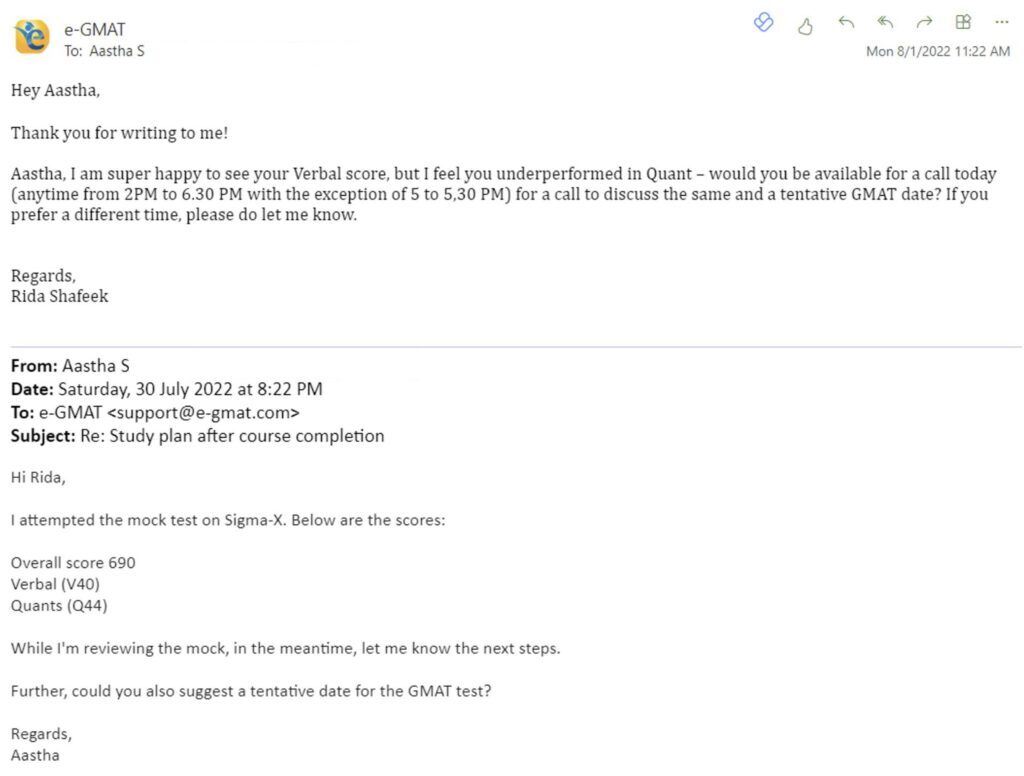
Those improvements you’d shared for topics I was not confident about were exceptionally critical for me at that stage. I was struggling to get the accuracy. Those plans really helped me better approach the mock with confidence.
Rida: In your first mock, you scored a 690, which’s when I asked you to enroll in the Last Mile Push program. I was confident about your potential. You were at Q44, and I knew you were not really there. I wanted to work with you to get you to your right potential.
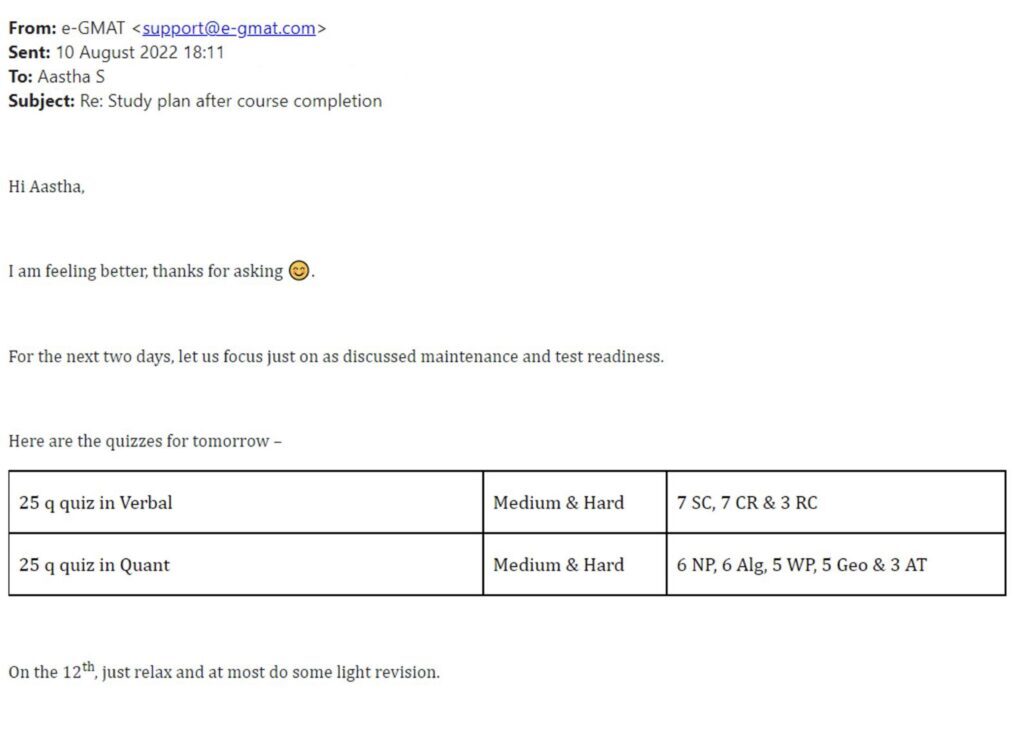
Rida: What changes did you bring about in your approach towards your mock and then the actual test?
Aastha: After the first mock, I obviously knew a 690 was not my true score. I was impressed with my verbal score, as that was my struggling point initially, and my confidence was remarkable. But I underperformed in quants. It was perhaps because I spent a lot of time improving my verbal before going for quant.
After the first analysis of my mock, you explained to me how to manage time during mocks. I was getting stuck on hard-level questions and spending too much time on them. I did not realize I could save that time and spend it on the last block of my mocks. Your input on how to distribute time for each section or block was what I carried forward for both verbal and quants.
Rida: There was a steep incline in your quant performance in mocks. You started with a 690, Q44, then Q49, and then to a perfect Q51 in your last mock. Your verbal mock scores were also steady around the 90th percentile.
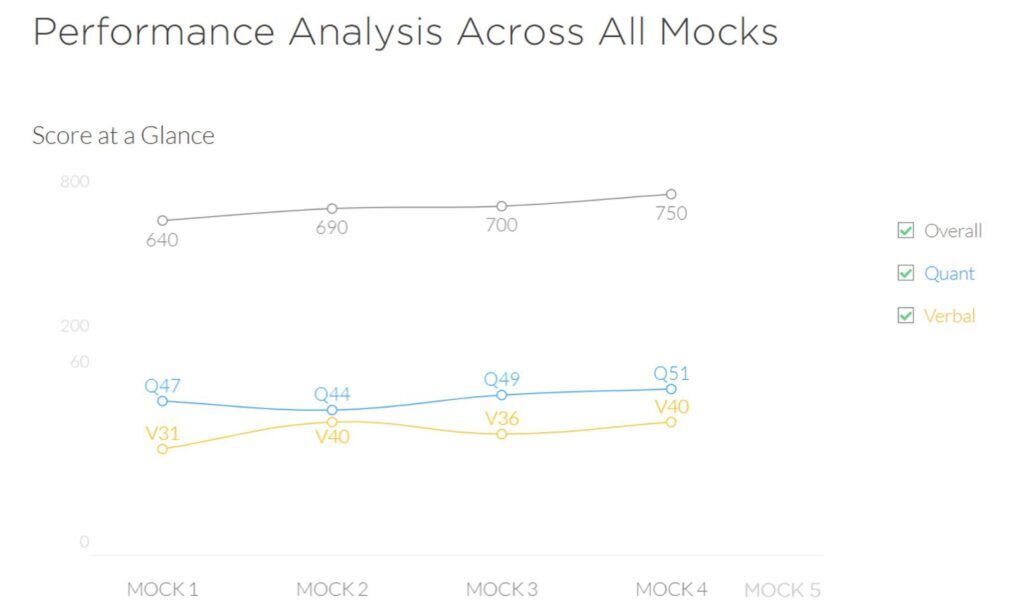
You took three mocks. Many people believe they need to take as many mocks as possible. How do you feel about that?
Aastha: Before I answer that, I’ll share what I was doing on this front during my first attempt before e-GMAT.
As you rightly said, many believe you must solve as many questions as possible to reach your target score. But after going through the course and cementing quizzes, I realized it’s not about solving 100-200 questions. You must apply the skills to targeted 30-40 medium and hard-level questions.
I even asked you how many mocks one should take before the exam date? And you told me 3-4 mocks are good enough depending upon my performance and improvements during those mocks.
While doing the strategic review and identifying my faltering points, I realized I didn’t need to take more mocks. In my first attempt, I took 6-7 mocks, but this time even after 3 mocks, I was comfortable enough to approach my exam day. For the 2-3 days in between mocks, I’d do test readiness questions as you had suggested. That also gives the same confidence as it’s similar to the actual test environment. Doing a thorough strategic review is better than writing too many mocks.
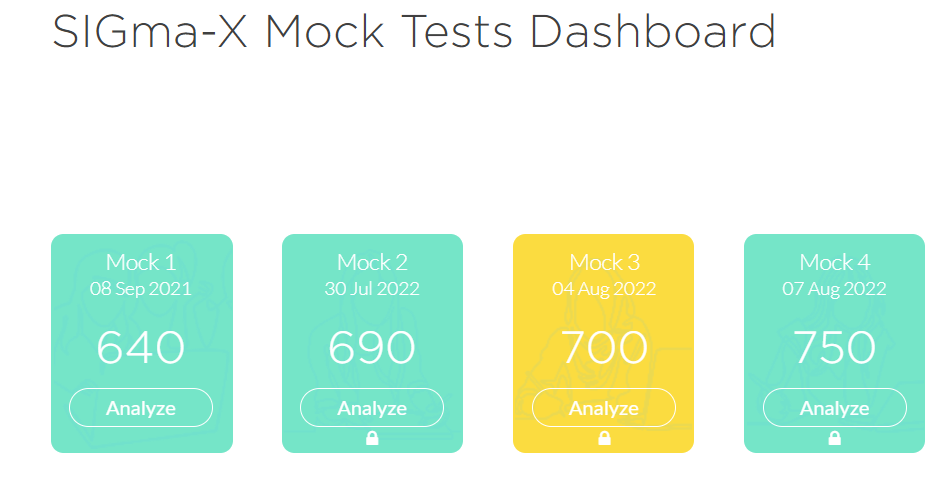
Rida: It’s interesting to see your ‘quality over quantity approach throughout your mocks and the number of questions you did. You did not even exhaust your question bank on the platform or the mocks available.
Reviewing the error-log
You also used the error log very extensively. How do you think it helped you in quizzes and mocks.
Aastha: The error log was a game changer for me. Honestly, I did not believe in the concept of an error log before e-GMAT. How could logging my mistakes help me? Until I did a strategic review, I entered every mistake and learned from it. Maintaining a detailed entry of all the feedback you’re putting in is more important than the mistake itself. So now, whenever I attempt a question, I’d think back about a similar question and the error I made there. For example, an inference question or assumption question having a reminder that the assumption must be true really made the difference for me. The answer choice analysis became pretty straightforward.
For the entire course, going through the error log is a must.
Rida: You took the maximum learning out of the error log. It’s not just about logging the mistakes but revising them to make the value addition they ought to make.
After your last mock, you took the GMAT exam. How did all these learnings help you during the exam?
Aastha: I was shocked to see my scores. During the exam, it did not feel to be going great. It was perhaps because I started getting more challenging questions on the steep line of increasing ability.
I was really delighted to finally get a great score.
Rida: Your story shows consistency, unlearning and learning new processes, and trusting, and following the course. These are the core of getting that dream score. Your concentrated directed effort was excellent.
Tips for GMAT aspirants
What tips would you give to other GMAT aspirants,
Aastha: I recommend making those small, regular efforts for improvement, such as maintaining an error log and entering detailed action points to extract the most out of it. From my personal experience, I didn’t appreciate the error log till the time I started revising the course.
After completing the course, I felt overwhelmed as it was a massive course;, so having that error log for section-wise mistakes and corrections was required. I advise maintaining an error log, referring to them to fill all the gaps, and taking those action points to mocks and quizzes and even warm-ups before your mocks.


